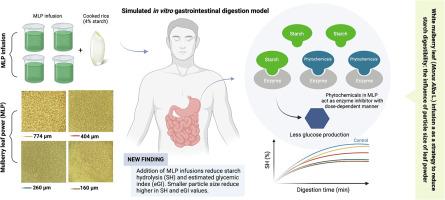White mulberry leaf (Morus alba L.) infusion as a strategy to reduce starch digestibility: The influence of particle size of leaf powder
IF 3.3
Q2 FOOD SCIENCE & TECHNOLOGY
引用次数: 0
Abstract
Mulberry leaf (Morus Alba L.) has been found in clinical trials to be effective in reducing diabetes in Asia. The powdered tea market is expanding in popularity due to its functional properties. This study aimed to examine the influence of different particle sizes of mulberry leaf powder (MLP) infusion on the digestibility of starch in cooked Japonica rice (cv. Koshihikari) and the bioaccessibility of phytochemicals. Dried mulberry leaf was pulverized and sieved into several particle sizes: 160 μm (MLP160), 250 μm (MLP250), 404 μm (MLP404), and 774 μm (MLP774). Through simulated in vitro digestion, we assessed starch hydrolysis (%SH), the kinetics of starch hydrolysis, estimated glycemic index (eGI), as well as total phenolic content (TPC) and total flavonoid content (TFC). The smaller particle size of MLP showed a greater reduction of eGI. Specifically, infusions prepared from MLP160 resulted in a reduction of 15 % in eGI for cooked grains and 3 % for slurries, respectively. The reduction in eGI was attributed to the interaction among flavonoids and digestive enzymes, demonstrating a concentration-dependent manner on enzyme inhibition effect. Pulverization significantly influenced the concentration of phytochemicals and their bioaccessibility in infusions. This study offers valuable insights into determining optimal particle sizes for MLP, considering both physical and functional characteristics as well as implications for the food industry. The results further suggest that MLP infusion holds promise as a functional beverage, potentially providing benefits in reducing postprandial hyperglycemia.

将白桑叶(Morus alba L.)浸泡作为降低淀粉消化率的一种策略:叶粉粒度的影响
在亚洲,桑叶(Morus Alba L.)在临床试验中被发现可有效降低糖尿病。由于其功能特性,茶粉市场正在不断扩大。本研究旨在探讨不同粒径的桑叶粉(MLP)浸泡液对煮熟的粳米(越光种)中淀粉消化率和植物化学物质生物可及性的影响。将干桑叶粉碎并筛分成几种粒度:160 μm(MLP160)、250 μm(MLP250)、404 μm(MLP404)和 774 μm(MLP774)。通过模拟体外消化,我们评估了淀粉水解率(%SH)、淀粉水解动力学、估计血糖生成指数(eGI)以及总酚含量(TPC)和总黄酮含量(TFC)。MLP 的粒径越小,eGI 的降低幅度越大。具体来说,用 MLP160 制备的浸泡液可使熟谷物的 eGI 降低 15%,使泥浆的 eGI 降低 3%。eGI 的降低归因于类黄酮和消化酶之间的相互作用,这表明酶抑制作用的方式与浓度有关。粉碎显著影响了植物化学物质的浓度及其在输液中的生物可及性。考虑到 MLP 的物理和功能特性以及对食品工业的影响,这项研究为确定 MLP 的最佳粒度提供了宝贵的见解。研究结果进一步表明,MLP浸液有望成为一种功能性饮料,在降低餐后高血糖方面具有潜在的益处。
本文章由计算机程序翻译,如有差异,请以英文原文为准。
求助全文
约1分钟内获得全文
求助全文
来源期刊

NFS Journal
Agricultural and Biological Sciences-Food Science
CiteScore
11.10
自引率
0.00%
发文量
18
审稿时长
29 days
期刊介绍:
The NFS Journal publishes high-quality original research articles and methods papers presenting cutting-edge scientific advances as well as review articles on current topics in all areas of nutrition and food science. The journal particularly invites submission of articles that deal with subjects on the interface of nutrition and food research and thus connect both disciplines. The journal offers a new form of submission Registered Reports (see below). NFS Journal is a forum for research in the following areas: • Understanding the role of dietary factors (macronutrients and micronutrients, phytochemicals, bioactive lipids and peptides etc.) in disease prevention and maintenance of optimum health • Prevention of diet- and age-related pathologies by nutritional approaches • Advances in food technology and food formulation (e.g. novel strategies to reduce salt, sugar, or trans-fat contents etc.) • Nutrition and food genomics, transcriptomics, proteomics, and metabolomics • Identification and characterization of food components • Dietary sources and intake of nutrients and bioactive compounds • Food authentication and quality • Nanotechnology in nutritional and food sciences • (Bio-) Functional properties of foods • Development and validation of novel analytical and research methods • Age- and gender-differences in biological activities and the bioavailability of vitamins, minerals, and phytochemicals and other dietary factors • Food safety and toxicology • Food and nutrition security • Sustainability of food production
 求助内容:
求助内容: 应助结果提醒方式:
应助结果提醒方式:


